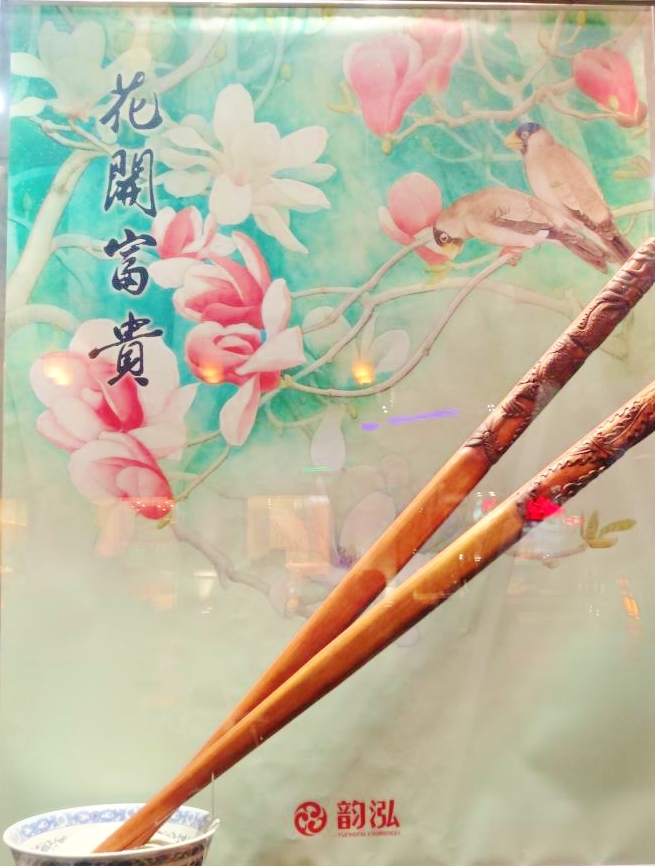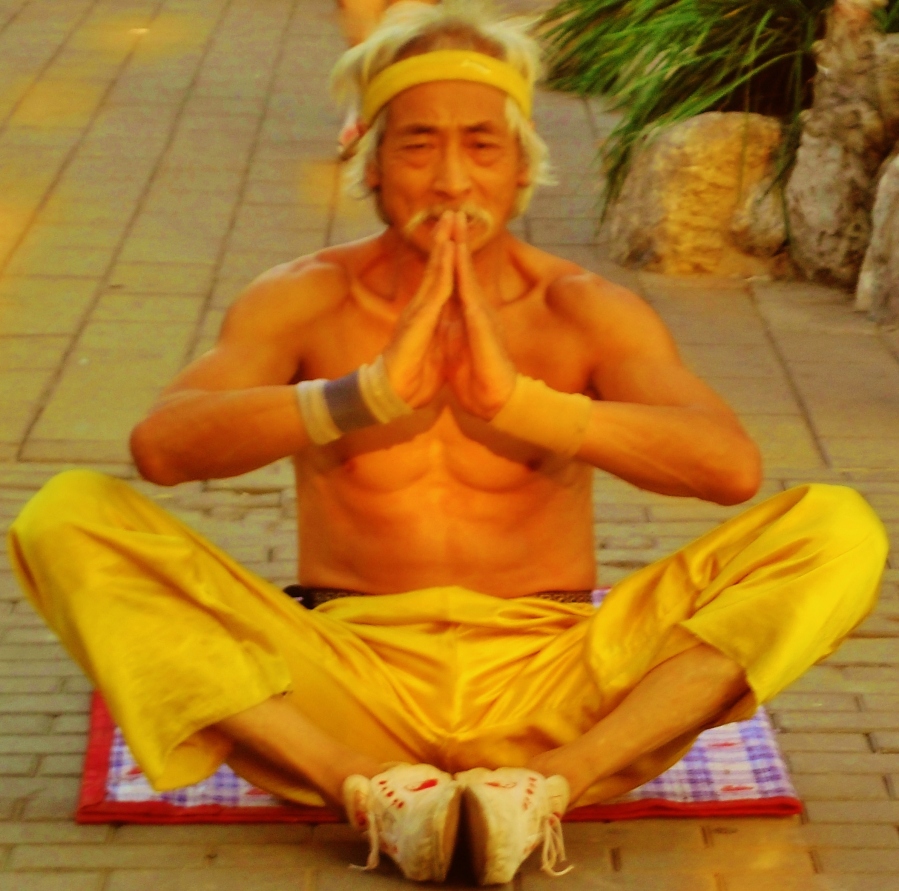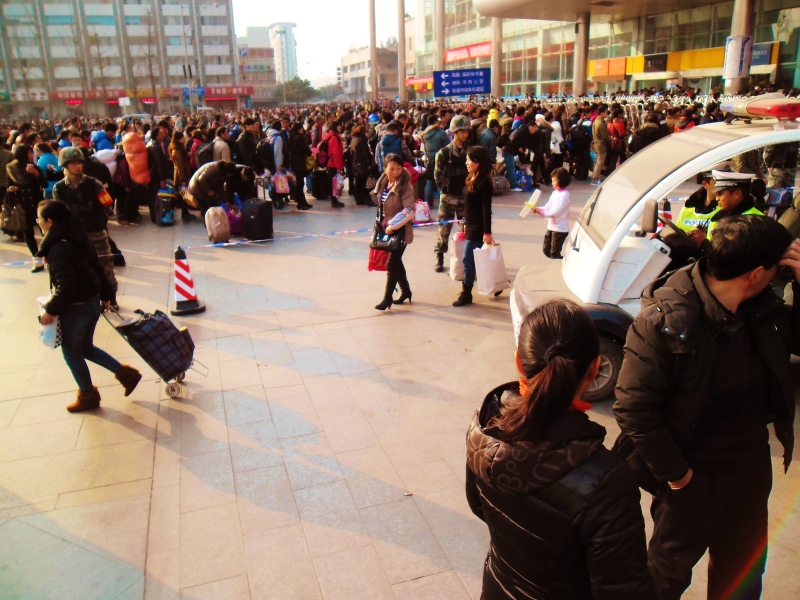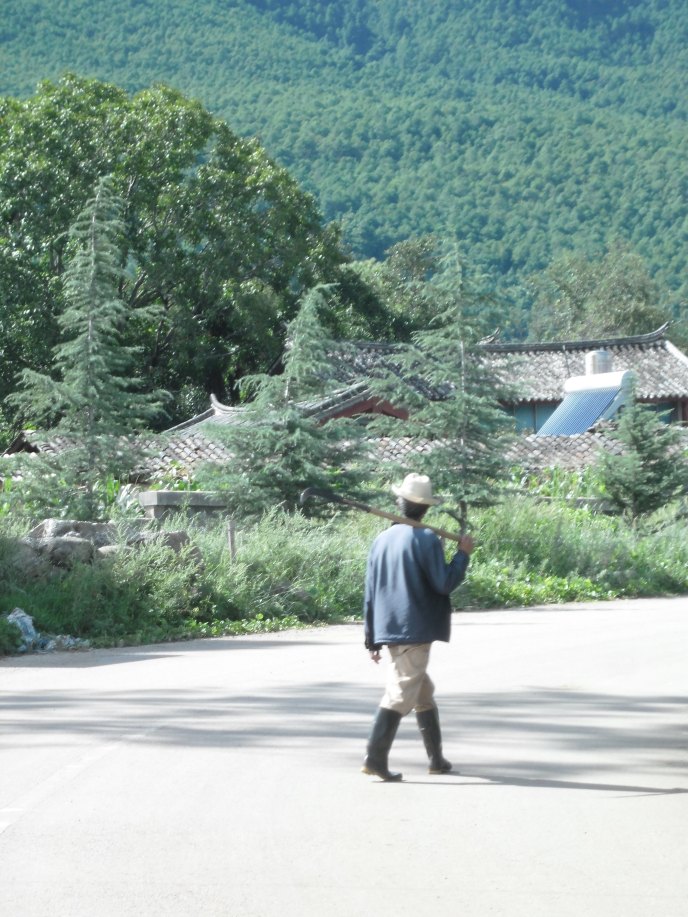Bite-sized China
Cultural fusion of the Eastern and Western Worlds

East meets west in this photo where the reflected backdrop of Shanghai‘s varied transport forms, high-rise buildings and red lanterns can be seen as sunlight falls on a Kate Winslet advertisement.
The above photo – taken in the fleeting instant when the setting sun in Shanghai reflects onto a Longines advertisement – encapsulates the changing shape of Shanghai in modern years and the curious amalgamation of western commercialism and traditional Chinese culture by which it is characterised, leading us to question just how sustainable one of China’s most booming cities is given its changeable nature. From transport, business, cuisine, architecture to art, education and fashion- the ultimate conflict of western modernity and chinese traditionalism is rampant in innumerable aspects of Shanghainese daily life.
-

Capitalism and traditionalism intermix in China’s urban cities as symbolically Chinese images of traditionally carved wooden chopsticks, Chinese rice bowls combined with Chinese calligraphy and decorative art are displayed in shop windows everywhere in an attempt to effectively ‘cash-in on culture’.
How far do you believe Chinese traditionalism will be eroded by western super-culture? Is the modernity of western commercialism evident in the streets of Shanghai simply a natural positive mark of financial progression from a low economically developed entity towards becoming a more economically developed entity?
Shanghai Baby, which is banned in China for its overt sexualism, is an engaging and award winning novel if you are intrigued by literature on the above-mentioned themes. This photo journal looks at China’s cultural development since antiquity and the following video on the tensions between Shanghai’s modern and traditional identities through art is also an interesting way to learn more. This more in-depth blog that explores the wider repercussions of the inevitable east/west conversion also offers a unique insight into the changing shape of Chinese culture.

Architecture strikes a surprising balance between modern and traditional culture on the streets of Mianyang.

A local sells her wares in the shadow of the vibrant flashing neon lights that now line the small fishing village of Yangshuo. Hit by an influx of mass tourism in the last 10 years, Yangshuo has proven an ideal getaway destination for travellers and a money-making hot spot for Chinese entrepreneurs from urban areas able to invest in new business, yet the majority of Yangshuo locals lack the experience, foreign language skills or capital needed to undertake such a venture and find themselves without employment in a village from which they are becoming increasingly alienated.

An eighty year old man finds his strength in ancient Chinese tradition and displays his mastery of the martial arts on the streets of Beijing.
Overpopulation

Army men and police officers patrol the crowd whilst passers by look on unphased at the heaving queues to enter the train station- a daily occurrence in the city of Chengdu that has a population of 11 million.
China’s Footprint in the Sky

As China’s market opens up to the outside world, over-crowded skies and high carbon emissions are an increasingly large cause for concern.
‘Women hold up half the sky’ Mao famously proclaimed in an attempt to promote equality of the sexes, conjuring a vivid image that simultaneously accentuates the significance of the sky in the Chairman’s mind. As women’s rights in China increase day by day; it is time now to turn towards the neglected sky itself. As the Chinese market opens up to international trade, China is set to become the biggest global superpower and it is no surprise that its skies are becoming worryingly overcrowded with passenger flights soon to overtake even the U.S. in numbers. We all share the same sky and with more than 10,000 flights a year leaving to China from airports around the U.K. and given Heathrow expansion plans to accommodate the growing demand for Chinese air traffic, the blood -or rather pollution- is on everyone’s hands.

Small countryside villages are among some of the only places in China that remain comparatively unharmed by the fatal acid touch of China’s progressively more polluted air.

Environmental attitudes in rural China slowly begin to change as foreign nationals join forces with local villagers in Sichuan in an effort to raise awareness of eco-friendly lifestyle choices.
The Great Wall
Thanks to its illustrious reputation as an impressive 2000 year old architectural structure, one of the Seven Ancient Wonders of the World and the only man-made object visible from the moon, the Great Wall of China continues to attract wide-eyed intrigue from the modern multitude who flock there in their thousands each year with holiday money, cameras and backpacks in tow.
Despite its lack of effectiveness in preventing the Mongolian invasion, no one could deny the fact that it powerfully symbolises the mighty ambition and ruthless domination of Emperor Qin Shi Huang and that its creation was a wildly impressive feat for which many millions of workers sacrificed their lives. However, it is important to dispel certain widespread myths:
1) Although -along with several other man-made creations such as motorways and dams- visible from outer space using photographic technology, it is true that (as NASA confirms) the Great Wall of China cannot be viewed from the moon with the naked eye.
2) Several documentations of the Seven Wonders of the World exist, some dating as recently as the 19th century, where the Great Wall of China is listed as part of the Seven Wonders of the World. In truth though, it does not belong to one of the original classical Wonders of the World dating back to antiquity.
3) The Great Wall is a classical masterpiece, but it is with some dismay that many unprepared travellers discover upon purchasing their tickets to the official entrance that the remains nearby have been so heavily repaired in recent years to ensure the health and safety of the hoards of visitors burdening its rather more frail ancient skeleton, that the most frequented parts of the wall seem in fact no more ancient than the very houses in which we live.

The Great Wall of China continues to be one of the most visited locations on Earth by both Chinese and non-Chinese tourists contributing in part to China’s recently exploding economy as the government increase the number of national holidays, encouraging holiday makers to travel and freely dispense their savings on souvenirs, local cuisine and guided excursions at such scenic spots.
Despite this enlightenment of many Chinese and non-Chinese tourists, the Great Wall nonetheless does not seem to greatly disappoint or deter as tourist numbers grow year upon year and the primary objective of many still remains of course, to have undergone the experience of a famed visit to one of the world’s most well-known structures; for many, Mao Zedong’s immortal words still ring true ‘不到長城非好漢’ (‘If we fail to reach the Great Wall, we are not men’). The more adventurous of explorers seal his words under their skin and determinedly undertake intrepid expeditions and sponsored marathons along the wall in the hope of unearthing more tales behind this mythical construction steeped in history and shrouded in enigma.
Food production
China has over a billion mouths to feed; given it’s geographically isolating conditions with its surrounding deserts and vast undulating mountains barring the routes, historically it has had to learn to fend for itself and not rely heavily on imports for nourishment. Today, China remains largely dependant on itself for agricultural produce, which in large part has enabled the country to economically flourish so dramatically post-1978.

Freshly made noodles drape theatrically from the ceiling as a noodle shop owner in the town of Anren near Chengdu reclines in her chair, sheltering in the shade from the scorching mid- August heat that reaches up to 38 degrees Celsius.

The late summer sun envelopes its final billows around what remains of the golden fields as the rice harvest comes to an end in South-Western China. Sweat-soaked and exhausted from another year of battling with the earth and sky, rice farmers carry their sacks of carefully sun-dried rice grains on their backs and are rewarded with the glistening white pearl-like bounty of a harvest that will nourish their families for four seasons to come.

As Northern China prepares for bitterly cold winters with temperatures falling as low as -38 degrees Celsius, Guangxi Province remains sunny and cool in January when the Pomelo harvest commences.
Have a browse of the following blogs if you want to find out about all things oriental! Overpopulation, The cultural Frontier, China: Photography Blog, Life After China, Biddle Writes, The Great Call of China, Lost in China, China Finance and The Best Architecture Photos of the Year.
Related articles
- The Love Story That Ended in the Great Wall of China. (flightinsmoke.wordpress.com)
- Communication with English! (eslnewyork.wordpress.com)
- Beijing to Great Wall (Badaling) by Train (alwaystravelicious.com)
- Inventions (ellaearlychina.wordpress.com)




















Ni hao Rachel,
Your photos of China are truly STUNNING – are you a professional photographer? if not, why not! Thank you for deciding to follow my blog. I have been living permanently in China for 4 years but have been coming here each year for 20 years, and have seen many changes and got to know many Chinese people. The more I know about this extraordinary country, the more I discover I don’t know. Always more to learn!
I will enjoy reading back through your blog.
Zai jian!
Great photos and report. I lived in China for several years and appreciate your understanding of the culture and its changes. Have you been to Harbin? It’s worth a trip, but too cold in the winter. Good luck.
Aw, thanks Herschelian and Soros Soria. I spent a year in China studying last year. The amount there is to know about China is quite overwhelming, but I have grown an attachment to this infinitely complex country in it’s beautifully imperfect state! Also, Soros Soria, yes, I have been to Harbin- I worked there last winter and it was so cold the inside of my nose would frost over when I breathed in!
I went to China for a few week study in Chinese Medicine, blogged to my friends and subsequently took two trips-ful of tourists back to my favorite spots. I , too, have developed many good friendships and an affection for the place despite an unquenchable thirst to understand its complicated history. It sure hurts to see people suffering with the economics and government . Enjoyed your blog photos! Hope I can get back there this summer for more discovery.
I like what I’ve seen of your blog – I looked at “Bite-Sized China”. I love your sophisticated language – you express yourself very well. I can really see the contrasts between modern vs. traditional Chinese culture. Your photos are interesting and sharp. Well done!
I just came back home to California from spending a week in Beijing. I loved reading your piece and I’m so intrigued to learn more about China. Such a fascinating place undergoing tremendous changes. Please keep sharing your wonderful photos and perspectives on the world. I’m hooked!
Very good photos. I worked in China for four years and miss it, but life continues and one must move on. I hope you continue to fulfill your karma.
Thanx for sharing your cool photos and info with us, Rachel. It’s nice to see some different international shots. Will have to come back and see more later. Many thanx for visiting my blog and have a wonderful day.
I like how you present your blog. It’s very informative and I look forward to reading your posts . Thank you for subscribing to my blog.
I really enjoy your style of blogging! It’s really informative and I’ve learned some things that I haven’t, despite having been to China so many times. 🙂 Also, thank you for the follow!
You write a social documentary text with photos and words. It is a way of catching the moment because you see and you feel the change. For me it is very interesting because I see the same in germany vice versa. I think the economy wants to make everything equal forgetting that culture is more than DIN and McDon. Great text
Reblogged this on street62.net and commented:
Social documentary photography about the chance in China in a double way – great observations!
Thanks for becoming a subscriber. Happy blogging.
Great report. Thanks.
How hilarious. Last year around this time I visited some of these cities i.e. Beijing, Guilin,and HK. Walking through the streets stimulated a creative spark in me thanks for the reminder. Tweeting this btw. ^+*
“Despite its lack of effectiveness in preventing the Mongolian invasion, no one could deny the fact that it powerfully symbolises the mighty ambition and ruthless domination of Emperor Qin Shihuang”
Qin Shi Huang Di was famous for ordering the construction of a new wall along China’s northern border, but that wall has almost entirely eroded away. The vast majority of the Great Wall today was constructed during the Ming Dynasty, after the Mongols were expelled. Now, it didn’t prevent the Manchus from conquering China from the north, but that was actually because the Ming general Wu Sangui opened the gates and let them in. Wu had hoped that they would oust the rebel and aspiring emperor Li Zicheng from Beijing…which they did, only to establish their own dynasty.
Dear Heathenchinese, Sorry if I caused confusion, perhaps my statement was rather broad, I just meant that emperor Qin Shi Huang built the wall with the intention of keeping the Mongols out but Ghengis Khan still managed to penetrate the wall ( perhaps because it was still earthen ramparts at that time) and then yes, later the Manchus once it had been completed by the Ming dynasty. I mainly wanted to emphasise that despite its great scale and the huge amount of suffering caused to its workforce, the Great Wall ultimately was not an effective deterrent to many of China’s invaders.
Very informative post, and nice pictures too! Hope you’ll keep on writing.
Fantastic photos, we are doing a bit of business with China and we are very keen to learn more about the traditional culture, East meets West, ancient and modern, keep it up. Will visit one day.
That reflection photo is really cool. It looks like some modern-retro crossover.
Such a great piece- loved all the eclectic bits and pieces- bite size is almost the only way to go with this huge culture and many of the tidbits you provided were fresh and fascinating to me. What a marvelous opportunity and great pics! So glad you dropped by my place- glad you liked it. Ditto!
Interesting questions and concerns you bring up here! I have often thought about these issues myself. I spent two summers in Beijing and the contradictions can be both frustrating and awe-inspiring. Love your blog–thanks for the follow! 🙂
Lovely Blog and great photos and insight into a life so far from my own. Thanks for transporting me there with you.
Thanks for the follow, and a great overview of modern China. I didn’t get to Shanghai, when I visited in 2000, but would love to have seen more of this fascinating place.
Regards from Norfolk, Pete.
We are a bunch of volunteers and opening a new scheme in our community. Your site provided us with helpful info to work on. You have done an impressive job and our whole neighborhood can be thankful to you.
An interesting discussion is definitely worth comment. I do think that you need to publish more on this subject matter, it may not be a taboo matter but generally people don’t talk about these topics. To the next! All the best!! what to do about depression
A lovely post as usual. I’ve been meaning to comment on this post but it usually takes me a bit of time to comment on your lovely posts so I left it until now. 🙂
You’ve touched upon quite a few points in the post, but I don’t think I can get to them all in a short reply here. Anyway. let’s start. As I’ve been saying in some posts in my blog, traditional Chinese culture doesn’t really exist in Modern “China” any more. A controversial statement but that’s my opinion. I am not sure if we should still use the term “China” for the current nation that it is today. PRC has been doing its best to be as un-China as possible for the last 60 years. The May 4th movement, was the major departure point in history, and its influences are still being felt today. Nationalism, Communism, and radical Westernization were progressing in a extreme pace that created the branching path that created the Modern “China” that is today. I wonder if the Americans foresaw all this? It was the American policies (along with the American influence to the Japanese) from back then that helped created the modern “China” that is their rival. Many intellectuals, the so called the true last generation of Chinese intellectuals with the proper all rounded Chinese education, may have created their own demise. People like Lin Yutan and Hu Shih (even though they escaped the blatant persecution) will never reappear again.
All that is a preface to explain the current Modern “China”. CCP was the force behind the radical westernization of China. Mao’s rallying cry in the CR was to get rid of ALL tradition, as they were useless in the NEW “China”. Their parents, useless, their teachers, useless, family relations, useless, intellectuals, useless, and ancient ruins, useless. One of the most famous story is the red guards digging up Confucius’s descendents’ corpses for mutilation, whippings and hangings. Whoever didn’t die from torture or etc (too many ways to die to mention), died in the years since or languished in prison for decades. Those that survived humans didn’t survive the Great Leap Forward and what that movement did to China. The usual number given is about 40 million death during those times. Both events contributed to the gap generations in terms of traditions and culture. Therefore, it’s understandable that Modern “China” has no traditional culture, nor do they care or treasure it.
If one is a true history buff and wants to see authentic things in China, you are probably out of luck. There are no authentic things anymore. Those that survived the trashing fro CR days, or the theft of materials for new construction, were mostly torn down to be build anew with concrete, rebar, and printed plaster decorations. Whatever couldn’t be made into money for tourism was made into apartment complexes that hilariously nobody lived in. It was depressing to see the Beijing’s preparation for the 2008 Olympics. They built new brick walls with fake facades in front old houses because it was not new, so too ugly to be shown. Corruptions didn’t help matters, as something that happened around my neighbourhood in Beijing was rather amusing. 3 – 4 million (I’ve heard higher numbers, but I’ll go with the lower one) USD was marked for the neighbourhood revitalization project, to fix the roads, clean up, repair buildings, etc. They ran out of money after a few fake walls were constructed on a road less than 500 meters.
So if one takes all these into consideration, it makes the current CCP’s rallying cry for the return of traditional Chinese culture in society, insistence on using what they called “han”zi, preserving local customs and traditions, and exporting Hans culture in a effort to shore up/increase the Chinese soft influence, hilarious. To be honest, nobody really doubts that they even care. If radical Westernization was your thing, that’s fine, and that’s why you kicked out the nationalists, that’s fine too. But it’s amusing to see the 180 when your political platform was the anti-traditional “elitist” style of government that supposedly didn’t care about the people. lols, anyway, “traditional” Chinese culture was forever changed by western culture 100 years ago, and it’s not a recent phenomenon.
A bit more political commentary than I would’ve liked, but I think that gives a rough idea on how things went. As for food production…, that’s a scary topic that I would rather not touch, for my own sanity and others’ plausible deniability. Has anyone ever wondered how a nation with 1.3 billion people feeds its population and yet is able to force food prices low enough to not cause a riot amongst its poor?
Keep up the good work, a wonderful job as usual.
Pingback: Documentaries about China, Part 9: City of Dreams, Dreams to Dreams, China Dreams? | Knocking on China's Door
This blog is full of life and color! Thank you for sharing these amazing thoughts and photos with us and for following my movie-review blog, Projected Realities! Take care, and God bless! =) I wish you well.
You are a very articulate writer and how you play with words makes me read through the entire blog…you should embark on writing for a magazine. You are very insightful!
Very thorough article! Particularly interested in your unique perspective on ‘travel blogging’ – mixing in real issues relevant to locals and travelers of the modern world.
I was actually wondering if you might be interested in guest posting this article on my website: http://www.travelerabroad.com.
It’s a brand new baby website, really only a rough draft right now. But I am hoping to turn it into a community of travelers – one in which readers can get travel inspiration and contributors can generate traffic to their own blogs.
Let me know what you think!
Cheers,
Kelly
My family has been on the fence about visiting China for ages now. After this post, I must say I’m a lot more intrigued. Maybe I need to hunt down a copy of Shanghai Baby! Great pictures!!
Enjoyed your blog. Lived in. China for almost 2 years…made me feel nostalgic to see the images….thanks!
This is really amazing! What would you suggest I do when I study in Beijing?